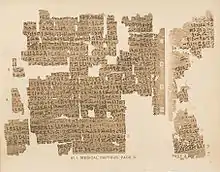Kahun Gynaecological Papyrus
The Kahun Gynaecological Papyrus (also Petrie Medical Papyrus, Kahun Medical Papyrus, Lahun Medical Papyrus, or UC32057) is the oldest known medical text in Egypt, although not the oldest in the world as in Philadelphia museum a Sumerian medical clay tablet from 3rd millennium is preserved.[1] Dated to c. 1800 BCE, it deals with women's health—gynaecological diseases, fertility, pregnancy, contraception, etc.


History
It was found at El-Lahun (Faiyum, Egypt) by Flinders Petrie in 1889[2] and first translated by F. Ll. Griffith in 1893 and published in The Petrie Papyri: Hieratic Papyri from Kahun and Gurob.[3] It is kept in the Petrie Museum of Egyptian Archaeology of the University College London. The later Berlin Papyrus and the Ramesseum Papyrus IV cover much of the same ground, often giving identical prescriptions.[4]
The text is divided into thirty-four sections, each section dealing with a specific problem and containing diagnosis and treatment; no prognosis is suggested. Treatments are non-surgical, comprising applying medicines to the affected body part or swallowing them. The womb is at times seen as the source of complaints manifesting themselves in other body parts, for which its fumigation is recommended, either by oils and incense or whatever the woman smells roasting, should it cause her to smell roasting.[5][6]
See also
- List of ancient Egyptian papyri
- Kahun Papyri
Bibliography
- O'Dowd, Michael J.; Philipp, Elliot E. (2000) [First published 1994]. The History of Obstetrics and Gynecology (Paperback ed.). New York: Parthenon Publishing Group. p. 43. ISBN 978-1-85070-040-1. LCCN 94019129.
References
- Kramer, Samuel Noah (1956). History Begins at Sumer (Third, 1981 ed.). University of Pennsylvania Press. pp. 60-64. ISBN 0812212762.
- Worton, Michael; Wilson-Tagoe, Nana (2004). National Healths: Gender, Sexuality and Health in a Cross-Cultural Context. London: UCL Press/Cavendish Publishing. p. 192. ISBN 978-1-84472-017-0. LCCN 2005295595.
- Griffith, F. Ll. (1898). The Petrie Papyri: Hieratic Papyri from Kahun and Gurob. London: Bernard Quaritch. (Please note the book pages run from back to front.)
- David, Ann Rosalie (1996) [First published 1986]. The Pyramid Builders of Ancient Egypt: A Modern Investigation of Pharaoh's Workforce (Paperback ed.). London: Routledge. p. 124. ISBN 978-0-415-15292-1. LCCN 85010775.
- Dixon, Laurinda S. (1995). Perilous Chastity: Women and Illness in Pre-Enlightenment Art and Medicine. Ithaca, New York: Cornell University Press. pp. 15f. ISBN 978-0-8014-8215-1. LCCN 94034911.
- "Manuscript for the health of mother and child", translated by Steven Quirke, University College London
External links
- Dollinger, André (July 25, 2009). "The Kahun Gynaecological Papyrus". An introduction to the history and culture of Pharaonic Egypt. Kibbutz Reshafim. Retrieved 2012-04-21.